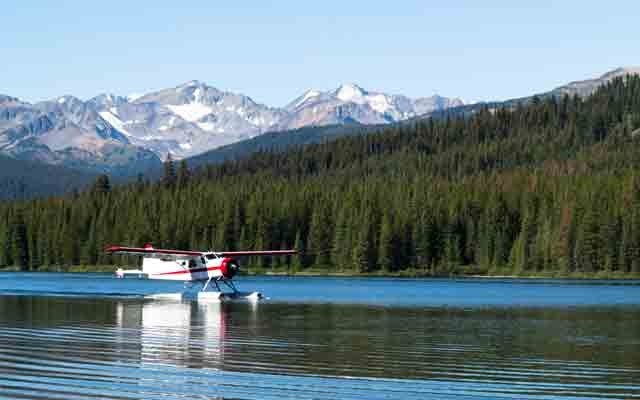BC Parks is in the final stages of developing its management plan for the South Chilcotin Mountains — an area that is both an important habitat for grizzlies, and a much-loved recreation area for mountain bikers, horse back riders, hikers and others.
The development of the plan has not been without debate. At least one commercial tourism operator is speaking out about his concerns over the new division of lands within the range for wilderness and recreation.
"In the (Lillooet Land and Resource Management Plan) process (BC Parks) recommended that the South Chilcotin area become a park, but they also recommended that the park be partially zoned for wilderness and partially zoned for tourism," said Tyax Adventures operations manager Dale Douglas.
"The biggest issue for me, is that the zoning that was put forth in the (current draft management plan has) the whole park basically zoned for wilderness. Tourism use was totally secondary."
A stated objective in the original LRMP document was to "honour pre-existing rights and tenures in new protected areas," and to "ensure that uses are compatible with protected areas designation, and which predate its legal designation (e.g. hunting, fishing, various types of recreation) continue to be accommodated in the protected area."
BC Parks released its Draft Management Plan earlier this year for the South Chilcotin Mountains Park and Big Creek Park, in which Parks has established its long-term vision and management objectives, as well as "responding to current and predicted threats and opportunities."
Public input on the plan closed on May 30 and it is currently moving towards final approval.
The South Chilcotins have become a mainstay of backcountry recreation in B.C. Four years ago 80 per cent of the 71,347 hectares of the Spruce Lake Protected Area (SLPA) was incorporated into the BC Parks system as South Chilcotin Mountains Park. The remaining 20 per cent was removed from the protected area and designated into three mining and tourism areas; Paradise Creek, Slim Creek and Taylor Creek.
Prior to 2010, the South Chilcotins were freely used by outdoor recreationalists just like any other crown land in B.C., as it had been for decades. It was also a favourite of commercial tourism operators in the area.
In its latest draft plan, BC Parks has zoned South Chilcotin Mountains and Big Creek parks into two Wilderness Recreation Zones, in which the draft management states: "These areas are especially important as Grizzly Bear security, areas where bears have minimal encounters with humans and maintain wary behaviour and to enable the parks to effectively act as a source for provincial recovery efforts. The intent is to minimize human intrusion into these areas."
Wilderness Zone 1 (30 per cent of park) will be designated as core wildlife habitat and Wilderness Zone 2 (70 per cent of park) will "allow recreational activities and facilities that will be integrated with a high degree of consideration for the needs of wildlife and sensitive ecosystems."
For BC Parks the main focus is protection of grizzly bears.
"Provincial wildlife biologists were consulted in regards to the impact of park users on the grizzly bear population and habitat," said the Ministry of Environment (MOE) in an email response to Pique. "Ultimately, effects of disturbance must be addressed with an understanding of the cumulative and synergistic nature of their occurrence."
Douglas is bewildered by BC Parks assessment of grizzly bear populations, which was estimated at 203 in the South Chilcotin Ranges in 2012 by the Ministry of Forests, Lands and Natural Resource Operations (FLNRO). Actual population counts were not taken by aerial means — though BC Parks have stated that they intend to do so — the government estimates rely on regression analysis with a set of pre-determined variables.
"The science doesn't support some of the recommendations that were made in the draft regarding wildlife and grizzly bears," said Douglas.
"Even in the draft management plan, if you read it, they say right off the get-go (they) don't have the data. How can you re-make recommendations that restricts certain uses when you don't have the data on how it affects the grizzly bears?"
When the MOE was asked by Pique about how impacts are measured on grizzly bears, it replied:
"A number of studies have been conducted on the biophysical effects of recreational activity (i.e. the impacts of mountain biking on grizzly bear populations and habitat). The statements in the draft management plan will be revisited to clearly reflect the most current research and predicted trends."
Bruce McLennan is a Wildlife Research Ecologist for FLNRO with over 25 years of experience working with grizzly bears.
"In general, bears habituate to predictable human behaviours such as people using the same trails at the same times of day and year," wrote McLennan in an email to Pique.
"If people can recreate wisely in grizzly country, then things can work out. If people do not recreate wisely, then bears end up being killed."
Douglas is adamant recreationalists and bears can co-exist if people act responsibly when passing through the Chilcotins.
"There's probably been 12,000 mountain bikers and 12,000 horseback riders that have used the park in the last 15 years and there's never been an incident," said Douglas.
While not encompassing the recreation area of Spruce Lake, Wilderness Zone 1 does envelope a lot of multi-use trails in the Gun Creek and Tyaughton Creek area, meaning that not only mountain biking, but all types of recreation in those zones will likely be restricted if the draft management plan follows its current zoning.
The future of recreation in the South Chilcotins. whether motorized, by bike, by horse or by foot, hangs in the balance.




